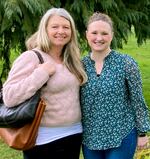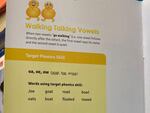Like lots of parents in West Linn, Maggie Traverso moved to this affluent city south of Portland for the quality of the schools. And until recently, she was satisfied. Her daughter was doing well in first grade, and was learning to read. So Traverso was surprised when she read that the West Linn-Wilsonville School District was using a reading curriculum the state hadn’t approved.
Traverso said she brought it up to another parent while they watched their kids on the playground.

Yarrow Currie (left) and Maggie Traverso have daughters in the same first grade classroom in West Linn. They're working with other parents to change the way local schools teach reading.
Rob Manning / OPB
“I was trying to make conversation,” Traverso recalled. “I said, ‘hey, so what did you think about that? You know, I think that they have everything OK?’ I don’t like to see our school district being publicized in the news negatively.”
Teaching kids to read is one of the most fundamental things an elementary school is expected to do. Yet declining test scores and a growing body of research suggest schools have been failing at this essential job. Not even four in 10 Oregon third graders are reading proficiently, according to standardized test results. It’s a problem that has gotten worse in recent years.
And though most West Linn parents, like Traverso, didn’t necessarily know it, reading instruction has become a flashpoint across the county, dubbed “the reading wars” by education insiders.
The fundamental question is whether kids should learn to read by first being taught phonics — how to sound out words — or by using an approach called “balanced literacy” which introduces kids to a variety of texts and teaches multiple strategies, such as using context clues to figure out unknown words. Research supports a primary emphasis on phonics, the skill of putting letters together to understand words. But many Oregon educators think a broader approach is still justified.
The state has effectively deferred to Oregon’s 197 local school districts on how to teach young students to read. The state includes many phonics-first options on its list of approved reading curricula, but doesn’t mandate that districts must choose from that list. That allows for districts like West Linn-Wilsonville to choose whatever curriculum they can get the local school board to approve, regardless of how effective it may be at actually teaching kids to read.
Traverso first heard about the issues in her own school district from fellow mom Yarrow Currie, on a playdate for their daughters. Currie has older children and saw more than one of them struggle to read in West Linn schools.
“I mean, I probably said too much at that moment,” Currie remembered later, laughing with Traverso about it. “I think I left thinking, ‘Oh, boy. I hope she calls me back.’”

Parents in West Linn-Wilsonville offer this workbook as an example of phonics materials used in a first grade classroom, by a teacher who is using a research-backed approach that differs from the district's adopted curriculum.
Rob Manning / OPB
Support for teachers and public schools runs deep in many Oregon communities, including West Linn. But Currie lambasted the district for its use of a balanced literacy program, which has been increasingly blamed for low reading scores across the country. The two moms stayed in touch and joined with other parents who started showing up at school board meetings to demand changes.
School administrators have maintained that the reading program was fine. But more and more parents disagreed. Kara Clark brought her daughter Madeline, a West Linn fourth grader, to a school board meeting last November.
Madeline has dyslexia, which makes learning to read even harder. Clark pressed the district to get on board a national movement called the “science of reading,” which emphasizes phonics and systematically teaching children to decode words.
“With the science of reading based approach with explicit and structured methods, my child might not be in the same situation that we find ourselves,” Clark said, with Madeline standing at her side. “This should not be just a concern for dyslexic parents but all parents. Seventy-five percent of children who are not proficient readers by third grade will never catch up.”
The national media attention and constant parent advocacy in places like West Linn-Wilsonville are new — but kids struggling to learn to read in the 9,000-student district is not. Julie Frazier’s oldest son is in high school now, but she remembers as a fifth grader he was an eloquent speaker, yet could barely write. She said that by fifth grade, his weak foundation in literacy made school really hard. He’d struggle through the school day in frustration.
“He was also having some pretty explosive behaviors when he got home,” she said. “I would find him crying in his closet with a paper that had a bunch of marks on it because things were wrong or he needed to do more.”
In theory, stronger phonics instruction could have helped Frazier’s oldest son. Researchers say phonics instruction builds a strong literacy foundation by third grade, so that when students get older, they’re better equipped to understand more complicated words and sentences.
The research on reading
More than 20 years ago, the critical importance of specific aspects of reading instruction gained official backing when the U.S. Department of Education’s National Reading Panel released its analysis of literacy instruction. The report noted the effectiveness of systematic phonics instruction and its fundamental precursor, phonemic awareness — the ability to identify individual sounds.
More recently, reporting on reading instruction has elevated the importance of systematic phonics, through such projects as the Sold A Story podcast, produced by American Public Media. Phonics and decoding are also the subject of a documentary called “The Right To Read,” which presents literacy as a major civil rights issue.
States have taken up the mantle of improving reading, with more than two dozen state legislatures approving laws aimed at aligning instruction with science-backed approaches. As of last November, 18 states and the District of Columbia were planning to use federal COVID relief funds to back “science of reading” approaches, emphasizing phonics and phonemic awareness, as well as vocabulary, fluency and ultimately, comprehension.
Despite the strong evidence that kids are more likely to learn to read on time when taught phonics, most colleges in Oregon do not lean heavily on phonics in how they approach reading instruction. The exception is Eastern Oregon University, which has a reading clinic that is training teachers in explicit phonics approaches.
When asked to weigh in, other academics in the state, including leaders at Portland State, Western Oregon University and Oregon State University, acknowledged the importance of phonics, but also said their approach maintains a broad focus.
Portland State points out that it has made changes following state laws passed in 2015 to better support the reading needs of students with dyslexia. However, much of that work is focused in the school’s program to prepare special education teachers and recent graduates say teachers in mainstream classrooms are not receiving the necessary reading instruction preparation.
Western Oregon University says it now teaches “a more systematic and structured approach” to what are considered the five main pillars of reading instruction, including phonics and phonemic awareness.
“There is not one way to best” teach reading, said Susan Gardner, dean of the college of education at Oregon State. “Everybody doesn’t learn the same way, everybody doesn’t think the same way.”
Gardner suggests the best way to improve reading outcomes is through smaller class sizes in elementary school and more one-on-one instruction. She favors a flexible approach that doesn’t lean too heavily on one strategy.
“What we try to do is prepare our future teachers to have as many tools in their toolbox as possible,” she said.

Reading expert Barbara Steinberg leans on a bookshelf at her office in West Linn. Steinberg trains teachers on systematic, explicit phonics instruction, an approach increasingly backed by research and brain science.
Rob Manning / OPB
Reading coach Barbara Steinberg, whose office is in West Linn, disagrees that there are multiple ways to teach beginning readers.
“What every child needs to learn to become a skilled reader is the exact same thing and it’s something that was not being taught to students in my school and most schools throughout Oregon and the United States,” said Steinberg, a reading expert who has trained thousands of teachers across the country in strategies aligned with the “science of reading.”
Sounding it out
Steinberg said her initial training emphasized a love of reading and exposure to varied texts. But she said it didn’t prepare her to teach students to decode words. Instead, she was taught to introduce strategies like using context clues, where a student would look at the other words in a sentence to figure out the meaning of an unfamiliar word. She found it didn’t work well, especially for her struggling readers.
“When you don’t have decoding and you only depend on: ‘Does it look right? Does it sound right? Does it make sense?’ Well, then you’re continuously relying on the strategies that have defined poor readers,” she said. “And those strategies just don’t hold as you continue through the grades and words become more complex.”
Steinberg went on to get a master’s degree focused on helping students with dyslexia. And she learned how to teach using phonics. Under that approach, instruction starts with explaining a specific rule and then teaching examples of the rule.
To show how the theory of phonics instruction works in the classroom, Steinberg opened a thick spiral textbook to a page explaining the rule for the sound “ch.”
“C-h makes the sound ‘cha’ and we only spell t-c-h when it comes after a short vowel sound,” Steinberg said. “Catch” is an example of this pattern, she said. “Now students have to learn that we have two different letter sequences that make that sound, right? C-h and t-c-h.”
The goal is for kids to learn these rules about pronunciation and spelling well enough that they can sound out any unfamiliar word. When kids are first learning, they will often recognize the word they sound out, since they already have enough knowledge of spoken language to understand grade-level books. As they get older, context clues may become necessary to figure out more complicated, unfamiliar words.
Some school districts in Oregon have made changes to incorporate much greater emphasis on phonics and decoding. Portland is moving in that direction. And so is Lake Oswego, West Linn-Wilsonville’s next-door neighbor.
A tale of two districts
Steinberg started training teachers and working with administrators in Lake Oswego almost 10 years ago.
“They’ve seen tremendous changes in their student performance,” since they changed their reading instruction, Steinberg said of Lake Oswego.
In 2015, when Lake Oswego was just starting to change its reading instruction, the district’s third grade reading scores were only five percentage points above neighboring West Linn-Wilsonville. By 2022, the gap in third grade reading between those districts had grown to 20 points. The demographics and income levels of students in the two areas are similar.
Since the 2015-16 school year, average Oregon test scores on third grade reading have gone down. West Linn-Wilsonville's passing rates have fallen even faster than the state average, while reading scores in Lake Oswego — where reading instruction changed nearly a decade ago — have held steady. Data source: Oregon Department of Education.
David Pryor is an assistant superintendent supervising elementary schools in West Linn-Wilsonville. Like other district leaders, he recognizes the importance of phonics, but thinks it shouldn’t exclude other methods of reading instruction.
“I wanted us to always be careful in education to not jump on the pendulum swing that goes, in one direction as a response, as opposed to bringing forward the best research and practices for our students,” he said. “I don’t know that it has to be binary. I think we can continue bringing forward a full comprehensive program that includes all the things we’ve been talking about — phonics, decoding and comprehension.”
Advocates of the “science of reading” say the comprehensive approach Pryor and OSU’s Gardner are talking about waters down the instruction and can confuse students.
West Linn-Wilsonville is exploring new reading approaches. But any big change there is a long way off — at least until fall of 2024. District leaders say they’re likely to choose two components — something comprehensive as a core system and a phonics supplement. District leaders say they’ll likely change to something on the state’s list of approved options.
But under Oregon law, they don’t have to.
Local control rules contribute to reading achievement disparities
Some states have mandated how reading instruction is done. But Oregon leaves a lot up to local districts, leading to pockets of success and wide swaths of failure.
Rebecca Puskas, also of West Linn, knows more than the average parent about state regulations. She’s a lawyer who works in state government. So when she started hearing from other parents about problems in how her local district taught reading, she wanted to know what the state required.
“You expect that if your kid is going to a public school in Oregon that they are using a reading curriculum that meets the state standards and has followed state requirements for adoption and approval,” Puskas said.

A page from a phonics workbook describes different letter combinations that make the long "o" sound.
Rob Manning / OPB
In fact though, West Linn-Wilsonville’s current curriculum is not on the state’s approved list. And that’s allowed, so long as they have support of the local school board.
“I set out to understand the process, but what I found was a compliance issue, and I think it really goes back about a decade, where the district has been using curriculum that hasn’t been through that formal process and hasn’t gotten school board approval,” Puskas said.
West Linn-Wilsonville administrators acknowledge that years ago, their predecessors didn’t completely follow the compliance process.
Using curriculum that’s not on the state’s list only requires checking the right boxes on a form the district sends to the Oregon Department of Education. The state doesn’t ask for details.
“The Department of Ed here does not even keep track — for their own records, let alone make it public — what curriculums are being used by the districts,” said Jennifer Schuberth, with advocacy group Decoding Dyslexia, which raises awareness and pushes to support children with dyslexia.
The result of such a hands-off approach from the state is that every district must fend for itself. In more affluent districts like West Linn-Wilsonville, parents have the time to research other options and advocate at school board meetings for change. They can also spend their own money on tutors, if their kids continue to struggle.
That local variation is one of the causes of a double-digit gap in reading scores between students from low-income backgrounds and the state average.
Eman Dong is a West Linn parent, but she’s also worked in lower-income schools in Oregon. Just over half of West Linn-Wilsonville’s third graders read proficiently. In some lower income districts, it’s less than one-third.
“I’ve actually tutored students in the middle school and even high school levels working at a lower socioeconomic school,” Dong said. “The lack of good reading instruction has really impacted them. They ended up in special education or behavior classrooms. And I mean, I truly feel like it’s all connected.”

Parents in West Linn offered this photocopied, decodable book as an example of reading material that a first grade teacher is using as part of a phonics-based approach, which differs from the school district's adopted curriculum.
Rob Manning / OPB
But it can be piecemeal even within districts trying to change. Schuberth says it’s another example of how hyperlocal education is in Oregon.
“People don’t realize that different schools in the same district are using different curriculums, different assessments,” Schuberth said.
It can even vary classroom to classroom. One reason Traverso, the West Linn parent who first read about her district’s reading woes in the news, was surprised to learn there was any issue was that her daughter’s first grade teacher was actually using explicit phonics instructional methods — even though it wasn’t the district’s official curriculum.
“I would have just been assuming that everything was going along as it should be and as it normally would in any other classroom in the district,” Traverso said.
She only learned her daughter’s experience was different from the rest of the district by chatting with Currie.
State legislators and education officials are having discussions about how to push school districts to improve reading outcomes while allowing some autonomy. Meanwhile, for children who aren’t getting strong reading instruction backed by their district, or their local school, or provided by their classroom teacher, it comes down to every family on its own.
Julie Frazier, whose sons struggled with reading a decade ago, estimates she spent thousands of dollars on tutors to help her older son learn to read. She has a teaching background, so when her younger son struggled, she went out and bought instructional materials and tutored him herself.
“That was less expensive than getting another tutor for my second son because both of my sons had dyslexia,” she said.
But not everyone can do that. Most families expect their taxes to fund proper reading instruction at their local public schools, without parents having to spend enormous amounts of time or money.
Advocates in West Linn-Wilsonville and in state organizations like Decoding Dyslexia say the best solution is a strong state framework. It would involve multiple parts including coaching for teachers, strict state oversight, changes to how colleges prepare teachers, and of course, the right curriculum.
At a recent legislative hearing, Gov. Tina Kotek testified in support of more consistency in reading instruction across the state.
“I’m thinking about those children right now who are experiencing housing instability and moving from school to school, each with different approaches of teaching them how to read and write,” Kotek said. “We must move toward consistent, high-quality literacy instruction across our state with complimentary approaches happening at a student’s home, in their community and at school.”
No one on either side of Oregon’s reading battle is completely satisfied with Kotek’s proposed bill. Phonics supporters would like the state to take an even stronger role and mandate schools teach from a limited set of materials, as some other states have done. Some argue that it’s impractical for each of Oregon’s 197 school districts to research and overhaul reading on their own, and it should be the job of the Oregon Department of Education to identify strong reading materials and ensure districts are using it. Education department officials are currently working on an early literacy framework intended to guide school districts.
Supporters of a more comprehensive, or balanced, approach to reading instruction see value in legislation in Salem this session, which would offer financial incentives to districts interested in changing their reading curriculum. They’re skeptical of restrictions on what schools can teach, pointing to local communities’ interest in being involved in what’s taught in children’s schools.
The debate over reading in Oregon is likely to continue beyond this year’s legislative session and the latest adoption cycle in places like West Linn-Wilsonville. Gardner at OSU said that the college is “in active conversations” about how to improve teacher preparation, with an “emphasis on phonological awareness as one of the foundational components of literacy.”
Gov. Kotek has discussed forming a bipartisan work group to engage with colleges of education to “reset” the literacy discussion in the state.
And if Kotek convenes that group, and it concludes that significant changes are needed, change will still come slowly. It will take a long time for Oregon’s elementary schools to fill up with teachers who are entirely ready to teach reading in a different way.
